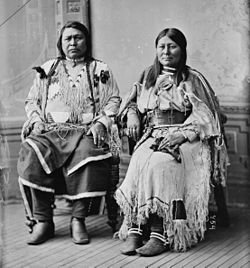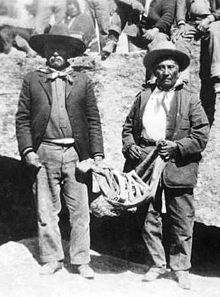- Chief Ouray
-
 Chief Ouray and Chipeta
Chief Ouray and Chipeta
Ouray (Arrow) (c. 1833–August 24, 1880) was a Native American chief of the Uncompahgre band of the Ute tribe, then located in western Colorado. Because of his leadership ability, Ouray was also acknowledged by the United States (US) government as a chief of the Ute.
In 1880 he left Colorado to travel to Washington D.C, where he testified to Congress about the Ute uprising of 1879. He tried to secure a treaty for the Uncompahgre Ute, who wanted to stay in Colorado; but, the following year, the United States forced the Uncompahgre and the White River Ute to the west to reservations in present-day Utah.
Contents
Biography
Early life and education
Ouray was born in what is now New Mexico. According to oral history, he was born on a clear night of November 13, 1833, during the Leonid meteor showers, which was taken as an omen. Some accounts state that he was born as early as 1820. His father, Guera Murah, was a Jicarilla Apache adopted into the Ute, and his mother was an Uncompahgre Ute. He learned Spanish, English, and later both the Ute and Apache languages, which he found helpful in negotiating treaties.
Marriage and family
He married Black Water and started a family with her. After her early death, he married Chipeta, who was 10 years younger than he. She became his close confidant. Although she did not have children, they reared his children by Black Water, as well as some orphans they adopted.
While Ouray was fighting the Sioux in 1863, his only son was taken captive. Despite attempts by the US government to gain the boy's release, Ouray was unable to find him. A decade later in 1873, visiting the Indian Commissioner at Cheyenne, Wyoming, Ouray heard from a woman who lived with the Sioux that his son lived, but had been sold to the Southern Arapaho. A search for his son was unsuccessful.
Becoming chief
At about age 18, Ouray came to modern-day Colorado to be a member of the Tabeguache (Uncompahgre) Ute band, where his father was already a leader. He spent much of his youth working for Mexican sheepherders, but fought both the Kiowa and the Sioux while living among the Tabeguache. At his father's death in 1860, Ouray became chief of the band, at the age of 27 (or possibly older).
Although Ouray sought reconciliation between peoples, with the belief that war with the whites likely meant the demise of the Ute tribe, other, more militant Utes, considered him a coward and called him The White Man's Friend. Ouray never cut his long Ute-fashion hair, though he often dressed in the European-American style.
The US government appointed a commission to determine a reservation for the Ute. Members were Alfred B. Meacham, former US Superintendent of Indian Affairs for Oregon; Otto Mears, a railroad executive, and George W. Manypenny, former US Commissioner of Indian Affairs. About the time that the government established the White River Indian Agency in western Colorado, the government recognized Ouray as chief of the Uncompahgre. The White River Ute had separate leaders. Chief Ouray and others traveled to Washington, DC to consult on the reservation. When President Rutherford B. Hayes met Chief Ouray in 1880 in Washington, DC, he said that the Ute was "the most intellectual man I've ever conversed with."[citation needed] Ouray also met President Ulysses S. Grant.
Death
Ouray died in August 1880 near Los Pinos Indian Agency in Colorado. His people secretly buried him near Ignacio, Colorado. Forty-five years later his bones were re-interred in a full ceremony led by Chief Buckskin Charley and Chief John McCook at the Ignacio cemetery.
Legacy and honors
Chief Ouray's obituary in The Denver Tribune read:
“In the death of Ouray, one of the historical characters passes away. He has figured for many years as the greatest Indian of his time, and during his life has figured quite prominently. Ouray is in many respects...a remarkable Indian...pure instincts and keen perception. A friend to the white man and protector to the Indians alike.”
- Ouray County and its county seat, the town of Ouray in Colorado are named for him.
- Mount Ouray in the Sawatch Mountain Range and Ouray Peak in Chaffee County, both in Colorado, were named for him.
References
Further reading
- H. Bert Jenson, "Chipeta: Glory and Heartache", The Outlaw Trail Journal, n.d., Salt Lake City, Utah, on Utah State University, Unintah Basin Education Center Website
- Grant, Bruce. The Concise Encyclopedia of the American Indian 3rd ed., Wings Books: New York, 2000.
External links
- "Chief Ouray", Southern Ute
- "Chief Ouray", History to Go, Utah State Website
 "Ouray". Appletons' Cyclopædia of American Biography. 1900.
"Ouray". Appletons' Cyclopædia of American Biography. 1900.- Find a Grave (burial site)
Categories:- 1833 births
- 1880 deaths
- Native American leaders
- Ute people
- People from New Mexico
Wikimedia Foundation. 2010.

